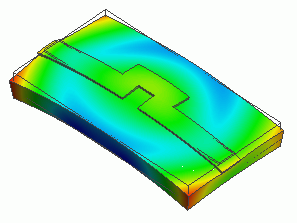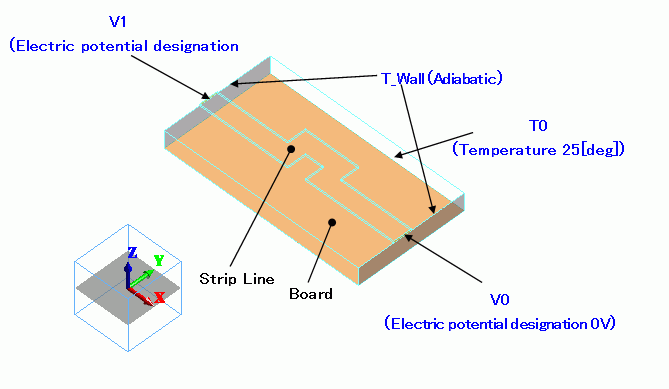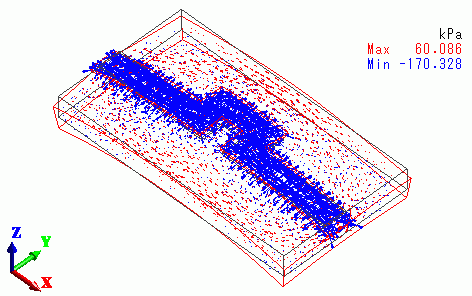
CAE Software【Femtet】Murata Software Co., Ltd.

Example1 Deformation of Conductive Strip due to Heating

General
-
Voltage is applied across a conductive strip line. The current going through the strip line is solved.
Then the eventual joule loss and temperature rise are solved.
By performing mechanical stress analysis, the deformation due to the temperature rise is examined.
-
The steady-state analysis is performed for the model on Exercise 2 of electric field-thermal coupled analysis. The results are handed over to mechanical stress analysis.
-
Unless specified in the list below, the default conditions will be applied.
Analysis Space
|
Item |
Settings |
|
Analysis Space |
3D |
|
Model unit |
mm |
Analysis Conditions
Solvers used are Curie and Galileo.
|
Item |
Settings |
|
Solver |
Electric field – thermal coupled analysis [Curie} Mechanical stress analysis [Galileo] |
|
Analysis Type (Curie) |
Steady-state analysis |
|
Options |
N/A * |
* “Thermal Load” is selected by default for the thermal load-mechanical stress coupled analysis.
The reference temperature is set on the Step/Thermal Load tab.
|
Tabs |
Setting Item |
Settings |
|
Step/Thermal load |
Reference temperature |
25[deg] |
* The reached temperatures come from the thermal analysis.
Model
The same as Exercise 2 of electric field-thermal coupled analysis.

Body Attributes and Materials
|
Body Number/Type |
Body Attribute Name |
Material Name |
|
0/Solid |
Board |
001_Alumina * |
|
6/Solid |
Strip |
008_Cu * |
* Available from the Material DB
It is assumed that there is no current flow in the alumina substrate.
|
Body Attribute Name |
Thickness/Width |
Analysis Domain |
|
Board |
|
Usable Domains: Deselect “For use in electric field analysis” |
Resistivity needs to be set for Board for [Curie] even though it is not used.
The resistivity is blank for 001_Alumina by default.
Enter 1.0 there tentatively. (The value doesn’t affect the simulation)
(This doesn’t affect the simulation) Set the specific heat of 001_Alumina as follows.
|
Material Name |
Specific Heat |
Resistivity |
|
001_Alumina |
1.0[J/Kg/deg] |
1.0[Ωm] |
Boundary Conditions
-
The temperature of the bottom face of the substrate is set to 25[deg] by the boundary condition of T0.
-
The faces where the strip line ends are set with the “adiabatic” boundary condition, T_Wall.
That keeps the outer boundary condition from being applied on them. -
Boundary conditions, V0 and V1, define the voltage at each end of the microstrip line.
-
The heat transfer to the ambient is defined by the outer boundary condition.
-
It is not fixed mechanically.
|
Boundary Condition Name/Topology |
Tab |
Boundary Condition Type |
Settings |
|
T_Wall/Face |
Thermal |
Adiabatic |
|
|
T0/Face |
Thermal |
Temperature |
25[deg] |
|
V0/Face |
Electric |
Electric wall |
Waveform: Constant, Voltage: 0.00[V] |
|
V1/Face |
Electric |
Electric wall |
Waveform: Constant, Voltage: 0.01[V] |
|
Outer Boundary Condition * |
Thermal |
Heat Transfer/Ambient Radiation |
Heat transfer coefficient: 10 [W/m2/deg] Ambient temperature: 25[deg] |
To set Outer Boundary Condition, go to the [Model] tab

and click [Outer Boundary Condition] ![]() .
.
Results
See Exercise 3 of electric field – thermal coupled analysis for the temperature distribution.
The deformation as a result of Galileo is shown below. The vectors represent the stresses. The unit is [Pa].

The temperature rise at the strip is high and causing the substrate to bend.

